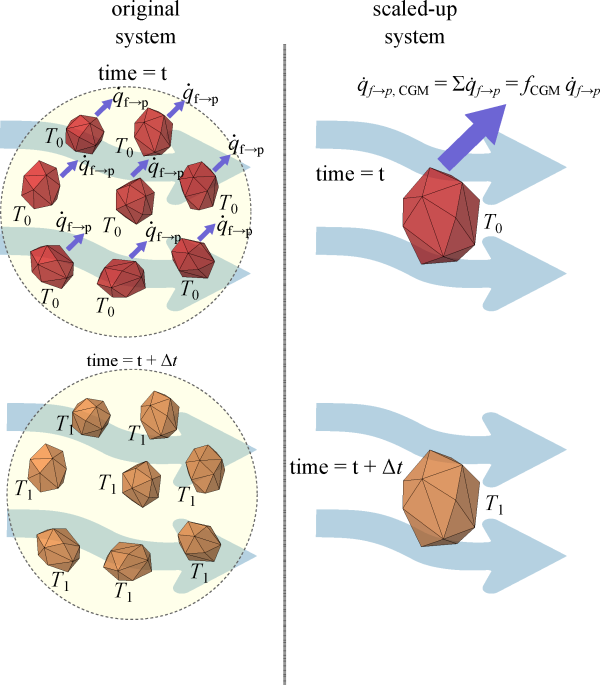In cases with heat transfer between particles and fluid, the constraint to the Coarse
Grain Model is to keep keep the same temperature variations in the scaled system as in the
original system. Figure 5.3: The heat exchange conserves
the temperature variations of the original
system when using CGM. shows a collection of particles, initially
at a temperature T0 exchanging heat with the
surrounding fluid. After a time interval of , the particles reach the temperature
T1. The scaled-up system should have this same
temperature, therefore ensuring the same energy transfer between fluid and particle phase. The
used in this example is 2.
Figure 5.3: The heat exchange conserves the temperature variations of the original system when using CGM.

As can be seen in Figure 5.3: The heat exchange conserves
the temperature variations of the original
system when using CGM., in a similar fashion to the fluid
forces, the total heat transfer rate due to convection on the parcel should be equal to the
heat transfer rate due to convection on a single original particle times the number of
particles the parcel represents, .
Corrections are needed for convection heat transfer rate given by Equation 4–2 for performing the correct scaling on the convective heat
transfer rate for CGM. As the , is equal to
times the area of the original particle,
, a single
is sufficient to reach the desired
scaling. Equation 5–3 shows the
final form of the convective heat transfer rate for parcels when CGM is used.
(5–3) |
A single scale-factor is necessary because the area of the parcel, , is equal to
times the area of the original particle,
, so this final addition is sufficient to reach the desired
scaling.
Finally, the convective heat transfer coefficient calculated for the scaled-up system
must be the same as for the original system, computed as Equation 4–3.
For this purpose, as the particle size is scaled up by , the fluid thermal conductivity must also be scaled by
, as shown in Equation 5–4.
(5–4) |
The Nusselt number, , is obtained from correlations. These correlations are functions of the
Reynolds and Prandtl numbers and of the local volume fraction of particles. Since the Reynolds
number was already modified due to the drag calculation, as shown in Equation Equation 5–2, the additional parameters are not changed when using the
CGM model.


